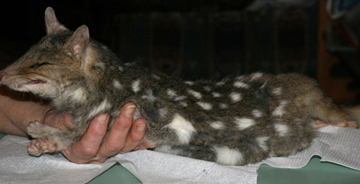Extinct since 1963, wild eastern quolls discovered in Australia
Jeremy Hance, mongabay.com
October 17, 2008
Two eastern quoll have been found as roadkill on the Australian mainland. Although considered extinct in Australia since 1963, these carnivorous marsupials remain abundant on the island of Tasmania.
While it may be possible that the quolls are remnants of a long-surviving population, it is far more likely they are descendants of escapees. Mount Rothwell Conservation and Research Center near Melbourne has been breeding captive quolls since 2002. Individual quolls probably escaped from the sanctuary into the wild; most likely the quolls found recently either escaped directly from the center or are descendants of escaped quolls.
 Eastern Quoll specimen. Photo by Marilyn Blankley |
Australian biologists are now working to discover how long these quolls survived in the wild. Although found in what was once their natural habitat, the area is populated by cats and foxes. Foxes and cats are introduced species in Australia and are blamed, along with habitat loss, for the extinction of eastern quolls. If the quolls have survived in the area for some time, it would mean the marsupials were successful in avoiding their unnatural predators.
Such findings would have important consequences for Tasmania as well, since foxes have recently been introduced on the island. It is unclear whether the foxes were introduced intentionally or by mistake.
Eastern quolls are nocturnal opportunists, eating everything from small animals, carrion, grass, fruit, and even garbage where it is available. While females give birth to up to thirty young, they only have teats for six causing the majority to perish. The eastern quoll is easily-distinguished from the other three Australian quoll species due to their white spotted body and white-tipped tail.
The dead quoll specimens were sent to Melbourne Museum for further analysis.
Story tip from Where Light Meets Dark














